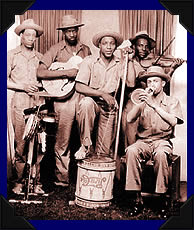Jug band facts for kids
A jug band is a band employing a jug player and a mix of traditional and home-made instruments. These home-made instruments are ordinary objects adapted to or modified for the making of sound, like the washtub bass, washboard, spoons, stovepipe and comb & tissue paper (kazoo). Though a true jug band must have a jug player, some people casually use the term jug band when referring to skiffle bands, spasm bands and juke (or jook) bands (see juke joint), which are other kinds of ensembles that incorporate a random mix of traditional and home-made instruments.
Instruments are often improvised, and in the early days of jug band music, guitar and mandolins were sometimes made from the necks of discarded guitars fastened to large gourds. The gourds were flattened on one side, with a sound-hole cut into the flat side, before drying. Banjos were sometimes made from a discarded guitar neck and a metal pie plate.
The jug is just that: a jug (usually made of glass or stoneware) played by buzzing the lips into the mouth of the jug , from about an inch away. As with brass instruments, changes in pitch are controlled by altering lip tension. The stovepipe (usually a section of tin pipe, 3" or 4" in diameter) is played in much the same manner, with the pipe rather than the jug being the resonating chamber. There is some similarity to the didgeridoo, but there is no contact between the stovepipe and the player's lips. Some jug and stovepipe players utilize throat vocalization along with lip buzzing, as with the didgeridoo.
Early jug bands were typically made up of African American vaudeville and medicine show musicians. Beginning in the urban south, they played a mixture of Memphis blues (even before it was formally called the blues), ragtime, and Appalachian music. It has been said that "The history of jug bands is the story of the birth of the blues". W.C. Handy said that he learned blues style from street musicians, playing improvised instruments. The informal and energetic music of the jug bands also contributed to the development of rock and roll.
Jug bands have continued to exist and evolve to the present day. John Sebastian still leads the J-Band. Some bands remain faithful to the original roots, while others continually expand the jug band repertoire to include other folk music, popular music, and classical music forms.
There has been an Annual Battle of the Jug Bands in Minneapolis, Minnesota held since 1980. Over 20 jugbands compete for the "Coveted Holliwood Waffle Iron" trophy. The competition is held the Sunday after the SuperBowl.
An annual JugFest gathering of jug bands is held each October in Sutter Creek, California, and a Jug Band Jubilee was in Louisville, Kentucky, the probable birthplace of jug band music, in October 2006.
Images for kids




